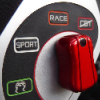
Z20Leh Rods And Piston Weight
#1

Posted 09 November 2010 - 08:05 PM
#2

Posted 09 November 2010 - 08:07 PM
#3

Posted 09 November 2010 - 08:26 PM
#4

Posted 09 November 2010 - 09:15 PM
#5

Posted 09 November 2010 - 09:30 PM
In fact you'll have to add some weight to the crank
Check randy's Europa build blog
however I don't think the build blog is still up
#6

Posted 09 November 2010 - 10:09 PM
#7

Posted 10 November 2010 - 09:43 AM
#8

Posted 10 November 2010 - 11:43 AM
#9

Posted 10 November 2010 - 11:49 AM
Edited by Nev, 10 November 2010 - 11:52 AM.
#10

Posted 10 November 2010 - 11:58 AM
In short, buying forged pistons for a Z20LEx block is a BAD thing unless you want to run crazy power.
It depends what your going to use your car for, the reason they need a bigger clearance is that the material expands more when it gets hot so if you treat the car right (i.e.let everything warm up at idel before giving it some) then the pistons will have expended to the correct size. But you can't just fit forged pistons and treat it like a production engine.
Edited by Winstar, 10 November 2010 - 11:59 AM.
#11

Posted 10 November 2010 - 12:04 PM
In short, buying forged pistons for a Z20LEx block is a BAD thing unless you want to run crazy power.
It depends what your going to use your car for, the reason they need a bigger clearance is that the material expands more when it gets hot so if you treat the car right (i.e.let everything warm up at idel before giving it some) then the pistons will have expended to the correct size. But you can't just fit forged pistons and treat it like a production engine.
is this still the case, with the forged pistons now adopting the same silica plus nickel alloys, don't you get a lot of the thermal expansion benefits that cast pistons have?
Yet, but its nature a forged much be much heavier than its cast item, to its advantage its cheap to manufacture as a generic blank then machine down to order.
#12

Posted 10 November 2010 - 12:07 PM
My measures for the 4 cylinders are between 86,002 to 86,005 mm, so it is
not necessary to rebore the engine.
On the other hand, I don't want to install a "big" turbo (with significant lag) on my car 310 hp with 840 kg is enought for me. (A big power need also an increase of the piston clearance)
To be clear today I know the weight of my new piston and conrods:
Piston : 318 g + 50 g (estimative to axle + ring)

Uploaded with ImageShack.us
Conrod : 552 g

Uploaded with ImageShack.us
ARP screw : 2x28 g
Total 976 g (to be accurate I will weight axle and rings)
today, I need to know the weight of the same OEM piston + conrods installed in the Z20LEH, in order to know the weight to be removed on counterweight of the crankshaft.
So if somebody could give me these exact Z20LEH weights I would be grateful to him.
Edited by chris, 10 November 2010 - 12:17 PM.
#13

Posted 10 November 2010 - 12:23 PM
is this still the case, with the forged pistons now adopting the same silica plus nickel alloys, don't you get a lot of the thermal expansion benefits that cast pistons have?
All depends on the material spec of the pistons I was assuming Nev had researched the cosworth pistons.
today, I need to know the weight of the same OEM piston + conrods installed in the Z20LEH, in order to know the weight to be removed on counterweight of the crankshaft.
So if somebody could give me these exact Z20LEH weights I would be grateful to him.
Chris
What Alanoo was saying above was that when the Hoffmans Europa (using arrow rods and LEH pistons) was dynamically balanced at vibration free then found that they needed to add tungsten inserts to the counter wieghts to improve the balance and even then they could not add enough
Edited by Winstar, 10 November 2010 - 12:26 PM.
#14

Posted 10 November 2010 - 12:34 PM
is this still the case, with the forged pistons now adopting the same silica plus nickel alloys, don't you get a lot of the thermal expansion benefits that cast pistons have?
All depends on the material spec of the pistons I was assuming Nev had researched the cosworth pistons.
CS quote 2618 alloy
The 2618, highest strength for the most serious race applications, has less than .25% silicon and a high expansion rate. The 4032, for milder applications, has 11 to 13.5% silicon and has an expansion rate similar to standard cast pistons. Hypereutectics, which typically have 16.5-18% silicon, are among the lowest rates of expansion. This amount of silicon is not used to make the aluminum stronger. It is used to reduce expansion by rejecting heat.
#15

Posted 10 November 2010 - 01:23 PM
is this still the case, with the forged pistons now adopting the same silica plus nickel alloys, don't you get a lot of the thermal expansion benefits that cast pistons have?
All depends on the material spec of the pistons I was assuming Nev had researched the cosworth pistons.
today, I need to know the weight of the same OEM piston + conrods installed in the Z20LEH, in order to know the weight to be removed on counterweight of the crankshaft.
So if somebody could give me these exact Z20LEH weights I would be grateful to him.
Chris
What Alanoo was saying above was that when the Hoffmans Europa (using arrow rods and LEH pistons) was dynamically balanced at vibration free then found that they needed to add tungsten inserts to the counter wieghts to improve the balance and even then they could not add enough
If you remove weight from piston and conrods you have to remove some weight (to be calculated) on counterweight.
It was the case of the Hoffmans Europa, I have photos which shown that some weight has been removed from cranksaht counterweights.
But may be they have removed to much and they need to put inserts to balance the crankshaft ...
Someone who knows the weight of the OEM Z20LEH piston and conrods ?
I don't care the strenght of these "tuning" pistons I just use this car to buy my bread !
Edited by chris, 10 November 2010 - 01:31 PM.
#16

Posted 10 November 2010 - 01:48 PM
#17

Posted 10 November 2010 - 04:46 PM
#18

Posted 10 November 2010 - 05:04 PM
Edited by alanoo, 10 November 2010 - 05:09 PM.
#19

Posted 10 November 2010 - 05:26 PM
#20

Posted 14 November 2010 - 03:24 PM
Chris,
Your piston pin will be a lot more than 50g alone
A good N/A pin is around 80g, a boosted one has more wall thickness and I'm sure it will be around 110g
318g is not bad for a forged boosted piston.
Cosworth and almost all other forged piston makers uses 2618 alloy which yes expands a lot and gives a lot of slap on cold starts (which wears the liners, the skirs, the rings...), but this is honestly not as bad as you think (especially with coated pistons) if you do not use your car on a daily basis (or bread buying trips).
EDIT : for anyone running forged pistons, NEVER use less than 100µm piston to bore clearance.
Yes you will hear audible slap on cold starts, even if you use a 2618 piston with OE bore to piston clearance... do not forget more bore clearance = more power too
You are right I have underestimated the weight of the axle, the real weight is of 101 g :

Uploaded with ImageShack.us
I have also to add the weight of the rods bearing : 154g /4 = 38 g

Uploaded with ImageShack.us
And the rings : 73g /4 = 18 g

Uploaded with ImageShack.us
The total of Conrods + piston + ARP screw + axle + bearing + ring = 317 +552 + 56 + 101 + 38 + 18 = 1082 g
I already have asked the question to Courtney who sold me these item, but there are unable to answer me, It is very stange that nobody make this exercice before.
It seems to me important to know what is the difference of weight between OEM items and these tuning item (especially for the reputed tuner who sold them !)
It is a technical devices !
1 user(s) are reading this topic
0 members, 1 guests, 0 anonymous users
















